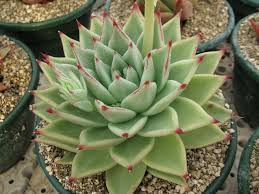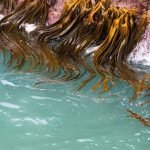The Echeveria Agavoides, is a species of plant with flowers of family of the Crassulaceae, native of the rocky zones of Mexico.
In particular, the states of San Luis Potosí, Hidalgo, Guanajuato and Durango.
They can be found with different shades, garnets, reds, burgundy, etc.
The Agavoides, is a succulent of perennial nature.
It forms a dense rosette with thick leaves that end at a sharp point, topped by a reddish stroke.
The surface of the leaves is smooth and light green, although it can become totally or partially reddish if the incidence of the sun is intense and prolonged.
Table of Contents
Description of Echeveria Agavoides.
The Echeveria Agavoides, is a star-shaped rosette, without stems, of fat leaves up to 20 cm in diameter.
The leaves are green, triangular, thicker, about 6 mm and sharper than the other Echeverias.
Hence the explanation of his name Agavoides, “like an agave”.
It is a plant that has different varieties, some have reddish tips and other forms have slightly red to very red margins.
This is a relatively common species, and quite fast.
It has also been widely used in hybridization.
The flower, long floral rod , carry in their end numerous bunches of flowers in the shape of lanterns, of pink orange color with the yellow interior.
It blooms in spring.
How to care for Echeveria Agavoides
The Echeverias, are succulent plants that can tolerate the sun, shade, wet soil, dry soil.
They look their best, when they are provided with adequate levels of light and water, ideally they should be grown outdoors in full sun.
Generally speaking, the more light a plant gets , the better its color and shape will be.
Bright light is needed to avoid the ” stretching ” of Echeverias.
( ” Stretching ” occurs when a plant of moderate growth, such as the Echeverias, is grown in low light or is fertilized excessively, which causes an exaggerated growth that contributes to pale and weak plants ).
However, by moving the plants from the lowest light conditions to full sun, it is possible that you can burn, by changing too quickly, to the intense sunlight of summer.
The movement of air is important to minimize the risks of pests and diseases and avoid excessive humidity in winter.
It can tolerate light frosts.
However, the ideal temperature range during the summer season is from 5ºC to 25ºC.
Cooler autumn temperatures tend to make their foliage colors become more intense than those of the active summer growing season.
How to water the Echeveria Agavoides.
The Echeveria Agavoides, needs normal waterings in summer, which will be moderate in the time of flowering.
Echeveria Agavoides supports drought well.
In the hot period moisten the substrate in depth and wait until it almost dries completely and water again.
In the winter season, water sporadically.
Substrate and fertilizer for Echeveria Agavoides.
The Echeveria Agavoides, are shallow and rooted plants and therefore benefit from good levels of organic matter in the soil.
You must have enough root space for optimal growth.
Slow release fertilizers with a low to moderate nitrogen content incorporated in the pot mix.
These are generally suitable for Echeveria spring and summer growing seasons.
Additional fertilizer applications would not normally be necessary until spring.
It should proceed in such an austere way, as it happens with the rest of succulent plants.
A few drops of diluted fertilizer, once a month between spring and summer, would be enough.
How to multiply the Echeveria Agavoides.
The simplest and most used form is by terminal cuttings and by outdoor shoots.
It is very easy to propagate or multiply.
Generally by leaf propagation or division of larger groups.
If the Echeveria Agavoides is replanted, for example, some of the lower leaves can be removed.
So we will try the propagation.
It is also a common practice to collect the leaves on the stem of the flower.
However, some of the cuttings will dry out without producing a plant.
After taking the cuttings you have to let them heal for a few days and then plant them in a sandy substrate.
The spread is easy and viable throughout the year.
We should keep the cuttings in a warm place and irrigate them sparingly.






